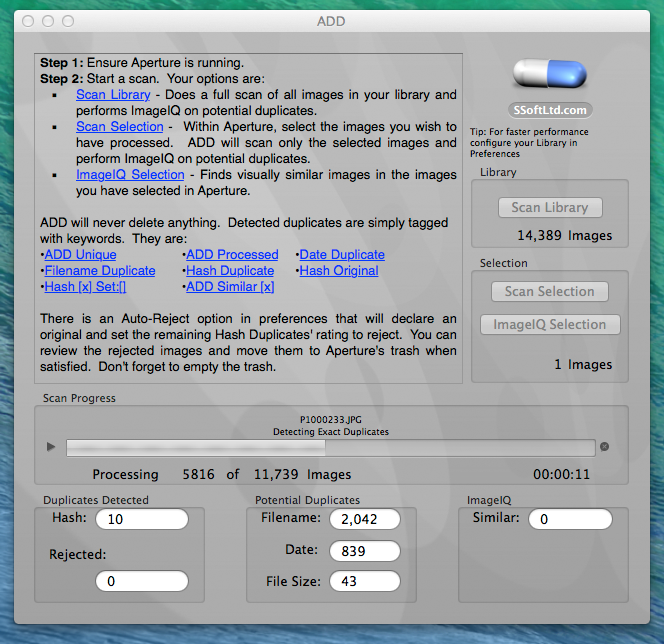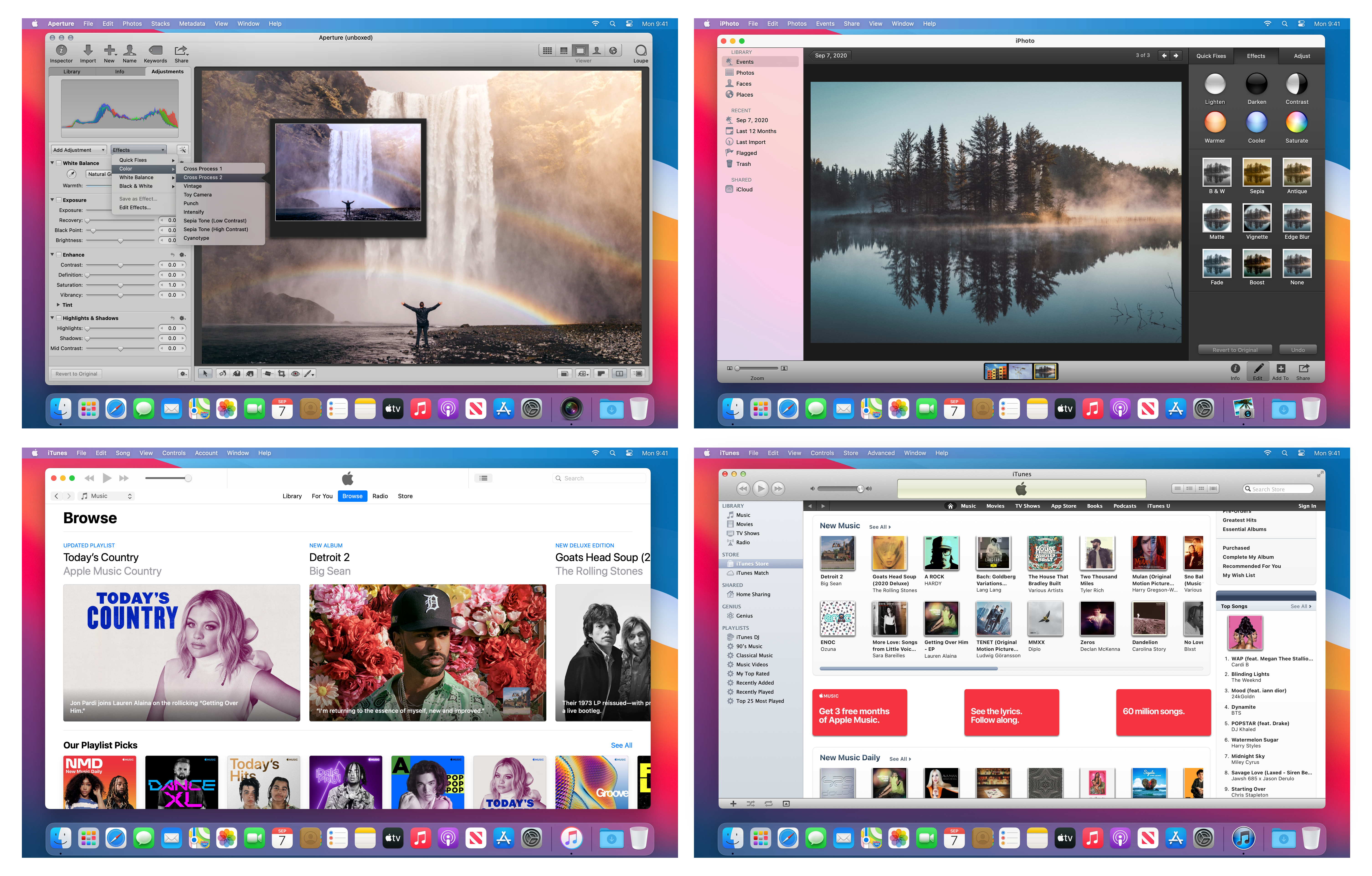Re: Aperture 3.6 displayed 'Unsupported Image Format' for Nikon Z6 NEF In reply to mosum. 1 month ago Mac OS support for Nikon Z6 RAWs is recent – it is only in Mojave.

MacOS Big Sur (version 11) is the 17th and current major release of macOS, Apple Inc.' S operating system for Macintosh computers. The successor to macOS Catalina (version 10.15), it was announced at Apple's Worldwide Developers Conference (WWDC) on June 22, 2020, and was released to the public on November 12, 2020. On June 2, 2014, Apple announced Photos as a replacement for Aperture and iPhoto. Aperture 3.6, a final update adding compatibility with OS X Yosemite, was released on October 16, 2014. Aperture was discontinued and removed from sale on April 8, 2015. Mojave is the last version of macOS to run Aperture. Aperture (3.6) AppCleaner Audition CC 2018 Autodesk Maya (2018.2 & 2016 ext 2 SP1) Backblaze Bartender BBEdit (12.1.4) Beamer Blender 2.79b Blender 2.8 beta Boxer (Dos Emulator) 1.4 Brackets BusyCal BusyContacts Caffeine Checkbook Pro Cisco AnyConnect Secure Mobility Client (4.6.01098) Cisco Jabber (12.0.1) Cisco WebEx Productivity Tools 31.20.2.18.
Aperture 3.6 Mojave Circle
Aperture will no longer run on any system past macOS 10.14 Mojave. See: Migrate your Aperture libraries to Photos or Adobe Lightroom Classic - Apple Support
Photos is the first native Apple application, that lets you store a photo library in iCloud and sync it across all devices. It is a successor to iPhoto, and its editing tools are now more versatile than they have been in iPhoto (in Photos 3.0). The support for metadata and projects like Books or slideshow ist still very limited. (Welcome to Photos - Apple Support)(Get started with Photos for OS X - Apple Support)
While the new Photos application has not much to offer for professional users accustomed to Aperture's tools to manage a large library and customize the tools and metadata presets for an efficient workflow, you may want to upload a subset of your photos to iCloud for easy access on all devices. To do that, export selected albums and project from your main Aperture library as a new Aperture library with 'File > Export > xxx as new library'.
The migration of the partial Aperture library to Photos will be smoother, if you take a few precautions.
- First of all, as always, when upgrading the system, make a full backup, so you can revert to the previous state. Make a Time Machine backup or a bootable clone.Ensure that your Aperture Library has no issues before the migration. Repair the permissions, and repair the database. (Repairing and Rebuilding Your Aperture Library: Aperture 3 User Manual)If your Aperture Library is not in your Pictures folder, but on an external drive, check the drive for compatibility. Photos may have problems accessing the drive, if it is on a network volume and not locally mounted. If you are planning to use the library with iCloud Photo Library, the drive must be formatted MacOS Extended (Journaled). And I strongly recommend to use only MacOS Extended (Journaled) volumes anyway. Move your Aperture Library to a correctly formatted locally mounted volume, if necessary. Even, if you are not planning to use iCloud, Photos may not be able to to migrate the library, if the file system is not MacOS Extended (Journaled). Photos can open a library on drives with a different file system format, but during the migration it needs to create hard links, and the file system must support hard links or the migrated library will be created on the system drive. See: Where is it safe to store a Photos Library? Requirements for the external driveThe first version of Photos (version 1.0) neither supports geotagging nor batch changing. If you have photos in your Aperture Library, that do not yet have GPS locations assigned, add the locations while your library is still in Aperture. Also, if you need to batch change titles or captions, do it in Aperture, while you can. Version 1.1 makes it possible to assign locations, but only on coarse maps without much detail. Version 1.1 lets you also assign titles or captions to multiple selected photos. Version 2.0 has more detailed maps, but these better maps are not available, when assigning places.Photos does not have projects, but structures the library by Moments and Collections, which are created automatically, based on the locations and capture dates. It is important to check the dates and locations for consistency, before you migrate. Later it might be difficult to correct them.Photos does not support hierarchical keywords, so flatten the keywords structure, while you can still use Aperture's Keywords HUD. Save your custom metadata tags to the captions field or wherever you can see them in Photos. Filenames are not used as default titles/version names in Photos. If you want to see filenames as the version name below thumbnails, you have to assign them as the version name.Since Photos does not have projects like Aperture, smart albums based on projects will not be transferred to Photos.
- How Photos displays Smart Albums from iPhoto or Aperture - Apple SupportSee here, what will migrate and what not:
- How Photos handles content and metadata from iPhoto and Aperture - Apple SupportYour new Photos library will be created in the same folder as your original Aperture Library. Make sure, you have free storage in that location. Photos will not duplicate your original image files from the Aperture Library, but link to these files to save space: Photos saves disk space by sharing images with your iPhoto or Aperture libraries - Apple Support
Don't delete your old Aperture Library in a hurry. It does not need much space, and you may need to revert to it, if the migration will not succeed. Photos will need additional storage during the migration that will be released later.Photos will migrate the last Aperture Library you opened before the migration automatically. So switch to the library you want to migrate, before you open Photos for the first time.Photos does support referenced files, but photos with referenced originals cannot be used with iCloud Photo Library. Photos has no tool to reconnect referenced originals like Aperture has. If an original is missing, you have to find it without a reconnect window like Aperture had. You can consolidate originals, but not relocate them.Photos does not support the merging of libraries. If you want to merge several libraries into one, do that in Aperture before you migrate your libraries, (Aperture 3.3: How to use Aperture to merge iPhoto libraries). See also: Notes on Merging Photos Libraries | Apple Support Communities
Good luck for your migration of selected Aperture Libraries to Photos.
BTW: There is no need to do the migration in a hurry, unless you got a new camera, that is not supported in Aperture. Both Aperture and iPhoto are supported on OS X 10.10.3 and still keep working on OS X 10.12.3, but there are a few glitches. The RAW Support added by macOS 10.12.2 does not seem to work with Aperture (Digital camera RAW formats supported by iOS 10 and macOS Sierra - Apple Support). The Print product support has stopped. You can continue to use Aperture 3.6 or iPhoto 9.6.1, while you are exploring Photos, so you will know, how to best prepare for the migration.
This User Tip by Old Toad lists the differences between iPhoto and Photos as a check list. It can help you decide, if you should migrate to Photos or not: Photos vs iPhoto: Features and CapabilitiesAs you can see, even basic iPhoto features are not yet supported in Photos. None of the Aperture features, that are not mentioned in the table are supported in Photos - brushed adjustments, saved presets, relocating managed originals as referenced originals, custom metadata tags, hierarchical keywords.
Only Aperture 3.6 is fully compatible with MacOS X 10.10.3, so you need to update to version Aperture 3.6. after upgrading to MacOS X 10.10.3.
But Aperture is no longer sold at the Mac App Store, and the Updates page will show 'Currently not available', and we can neither update from the Updates page nor buy the upgrade from the main 'Featured' page of the store.
Aperture 3.6 Mojave Vs
As a work-around: Reinstall Aperture instead of updating it.
If Aperture is associated with your AppleID as you bought it originally from the Mac App Store or you accepted a boxed Retail version to your AppleID when you updated to Aperture 3.4.5 or later, you can reinstall from your Purchases page. In all other cases you need the help of the App Store Support as described in the last paragraph.
- Open the Purchases tab of the AppStore and sign into the Store menu with your AppleID. Is Aperture listed among your Purchases? It may be hidden. Try to unhide it, see this link: http://support.apple.com/en-us/HT4928
- Then proceed as described in Barney-15E's User Tip for iPhoto: (I replaced 'iPhoto' by 'Aperture' in the quote)
Just as a precaution, copy Aperture from your Applications folder onto an external disk or USB stick and eject that drive.
Delete Aperture from your Applications folder. Make sure there are no disks mounted that have a copy of Aperture on them. Empty the Trash.
Make sure no other users have Aperture open in the background. It is best to have all other users logged out.
I ended up having to Restart before I could clear Aperture from the App Store memory (it was still showing Update on the button in Purchases).
If it is still showing as Update, try searching Spotlight for Aperture. There may be a copy on a mounted external disk that it is identifying.
You should now be able to go to the Purchases tab and find Aperture with the Update button labeled 'Install'. Click 'Install' and it should download the current version which works with Yosemite.

When I first tried, after authenticating, it posted a 503 error and asked if I wanted to Retry. When I clicked 'Retry,' it started downloading.
It's about 1.01 GB, so it takes a little while to fully download.
2. If your Aperture 3 version does not show at the Mac App Store Purchases page, give the App Store Support a call. There is a 'Support' link in the Quick Links on the main page of the Mac App Store. Ask for a redeem code to be able to download the update. You will probably need to provide a proof of purchase and be very insistent.
Alert: Aperture vanished completely from the Mac App Store and is no longer available for reinstalling since September 26, 2015. This User Tip does currently no longer work. This no longer applies. Apple restored the ability to reinstall oldr pruchases. http://www.macrumors.com/2015/09/29/older-software-returns-mac-app-store/

